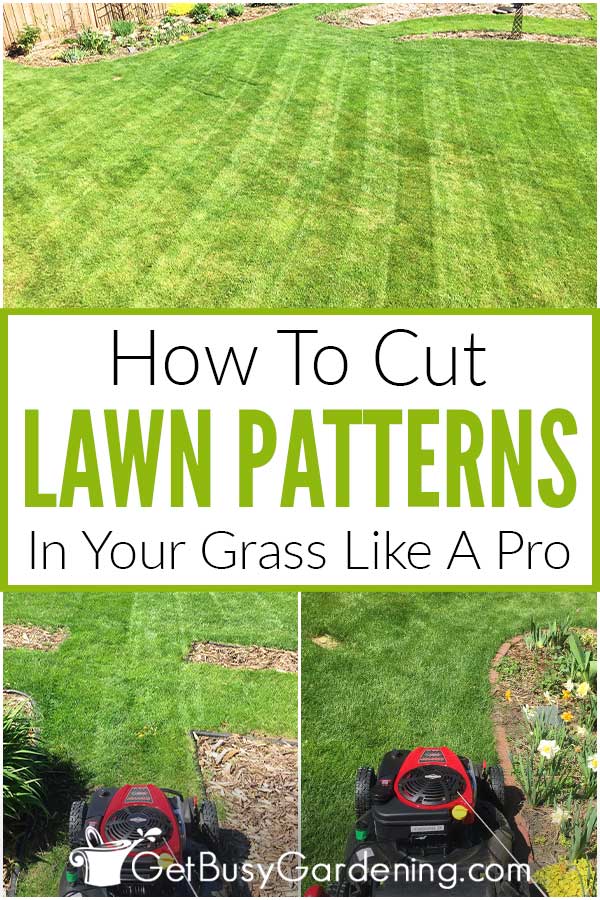

Using lawn mowing patterns to cut your grass is beneficial, and makes the chore of cutting it more fun. In this post, I’ll tell you all about how to use different grass cutting techniques to create those nice straight lines in your yard, just like the pros.
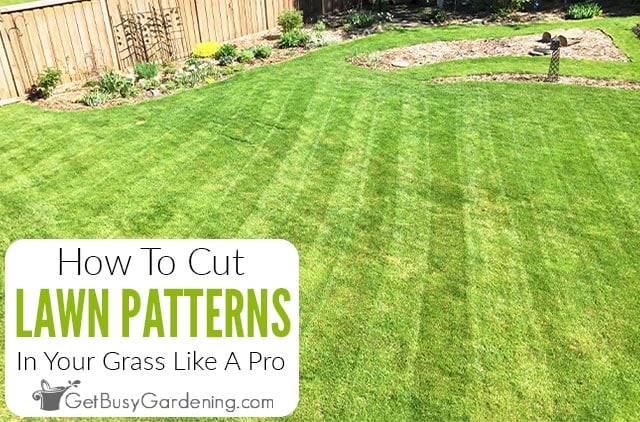

Learning the basic lawn mowing patterns will make your yard look amazing, and it’s also better for the grass too.
You don’t need to spend tons of extra time learning how to cut grass like a pro, it’s all about being intentional with the way you mow.
When you are more intentional, it becomes much easier (and more fun!) to maintain a healthy lawn.
In this detailed guide, you’ll learn all about the different grass cutting techniques and patterns, and how to easily use them to make nice designs in your lawn.
Table of Contents
You don’t need to be completely obsessed with having the perfect lawn to use mowing patterns. Some people totally geek out about it, and that’s cool.
I’m not one of those people, but I do like to maintain the grass and keep it looking nice (after all, it is often the backdrop for my gardens in photos).
Being intentional about how I mow, and using simple grass cutting patterns, makes it much easier to maintain a healthy lawn.
Even if you could care less about creating perfect stripes or patterns in your grass, it’s still important to pay attention to the way you mow.
Not only will your yard look nicer, your grass will be healthier, have less weeds, and be easier to maintain.
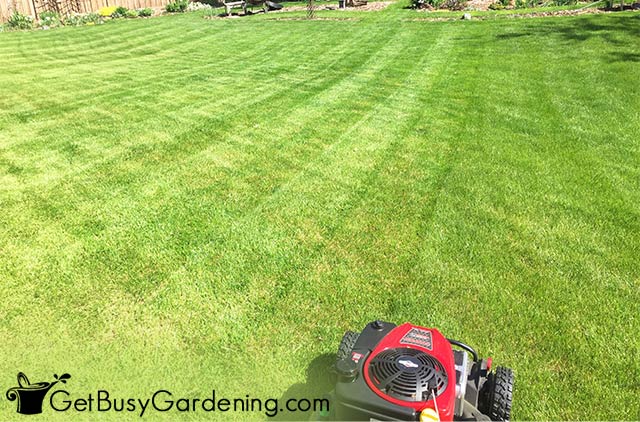
Here’s the deal, if you always use the exact same pattern every time you mow, the tire tracks will start to wear out areas of the grass. This can cause ugly dead spots, which invite weeds to grow.
Using the exact same cutting pattern over and over will also compact the grass over time, making it harder for healthy new blades to grow.
Switching up your routine on a regular basis minimizes the wear and tear damage caused by the mower tires.
Alternating mowing techniques also keeps the grass from becoming compacted, allowing plenty of airflow, and keeping it looking its best.
Plus, you need to mow it a little taller in order to get the right effect, which is better for the grass too (but more on that later).
And, as an added bonus, mowing patterns into the grass also helps to hide the weeds, giving the illusion of the perfect lawn.
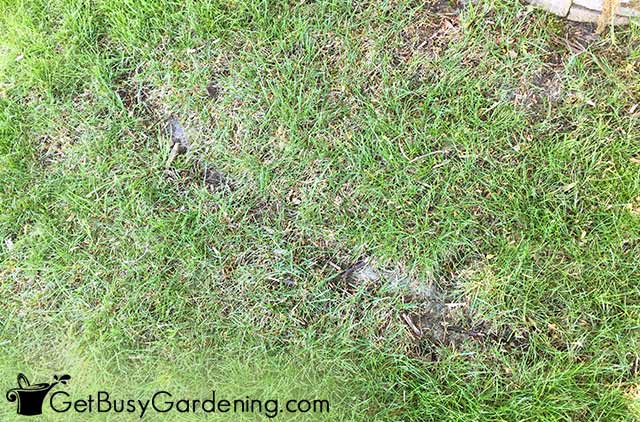
If you want to mow your lawn like a professional (or just maintain a healthier yard), then learning the basic patterns is key.
There are a few simple techniques you can play around with to see which ones you like.
The easiest one to start with is creating stripes in your lawn. Once you get the hang of that, it will be simple to create other designs.
Other common designs are the checkerboard pattern, straight diagonal lines, a criss-cross diagonal pattern, and diamonds.
It might sound like things just got complicated, but all of these fancy designs are just variations of the simple striping pattern.
There is no perfect pattern to use on every lawn. I personally like to mix it up, and use a different one every time.
But I have a large yard that is pretty square, so I have plenty of room to experiment. If yours is oddly shaped or small, you might find that only one or two of the designs will work.
Once you figure out the ones that look the best in your yard, and are the easiest to create, mowing actually becomes kind of fun.
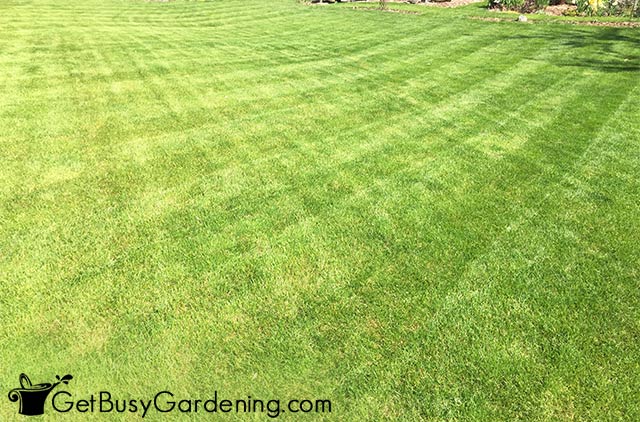
Making lawn striping patterns won’t add any work, it just takes a little extra thought and a bit of planning at first, so you can visualize what you want to do.
You don’t have to mow over and over again, spending extra hours to create the stripes and patterns. It’s all about how the grass lays after you cut it.
As your mower goes over them, the blades of grass will bend in that direction. Then when you go the other way, the grass bends in that direction.
The light reflects off of the blades differently in each direction – and that’s what makes the lines.
Mowing the grass taller (raising the lawn mower height) will make the stripes show up better, because longer blades bend more than short ones.
You don’t need any special equipment to create the professional look in your own yard, any push or riding mower will work. Here’s how to create those pretty lawn stripes…
Step 1: Cut the outside edges – Mow around the outside edges of your yard first (just like when a Zamboni starts cleaning the ice).
This is where you’ll turn your mower as you’re cutting the rest of the grass. Having a few feet of turning space makes it much easier to create straight lines.
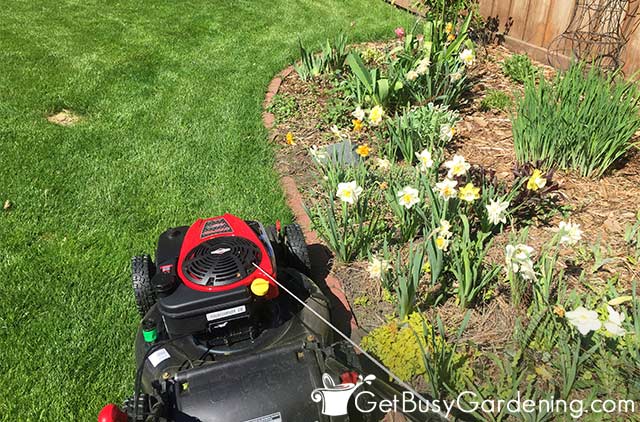
Step 2: Line up the first stripe – Make your first stripe using a landmark to keep it straight. I use the edges of my garden beds to help me get a nice straight pattern that matches the lines already in my yard.
You could also use a sidewalk, driveway, patio, or some other straight-edged hardscape in your yard as a guide.
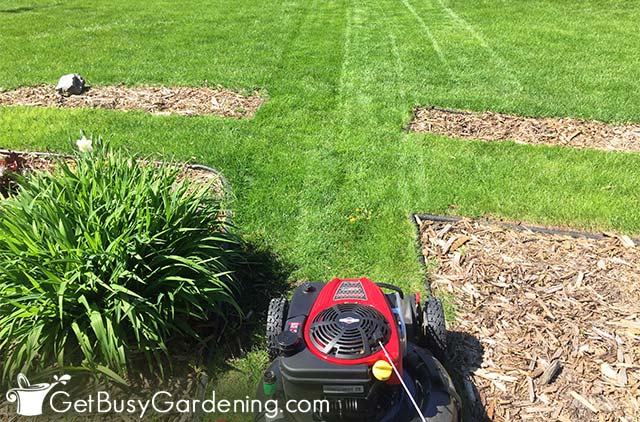
Step 3: Use the first stripe as your guide – After you make your first stripe, turn your mower around on the outside edge of the lawn where you’ve already mowed.
Line your mower up so that the wheels are on the edge of the line you just created. Then follow that line to create your next stripe.
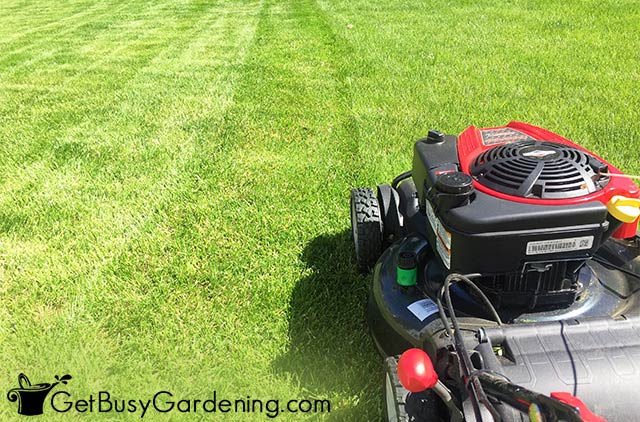
Step 4: Repeat the same pattern – Continue going back and forth over your lawn, lining your mower up after each turn with the last stripe you created.
Each new stripe you make will be in the opposite direction of the last, creating those nice clean lines. If you end up with a crooked line, just mow back over it in the same direction to fix it.
Step 5: Go over the outside edges again (optional) – Once you’re done creating your lawn stripes, go back around the perimeter of the yard again.
This will get rid of any turn marks left over from your striping, and any unsightly clumps of grass that were dropped by the mower.
Taking this extra step gives the lawn a more finished look, but it is totally optional. If you’re already happy with the way it looks, then you can skip this step.
Once you get some practice making nice straight lines, play around with other patterns and designs to see which ones you like the best in your lawn.
It’s important to note that the type of grass you have can make a big difference in how dark your stripes will be.
We have Kentucky Bluegrass, which is a variety that does better in cooler climates (like we have here in MN). It has a longer blade, and is thicker and lusher than those you’d find in warmer climates.
If you live in a hot climate, have a shorter variety, or one that has a more stem than blades, it won’t bend as nicely as the longer grass types.
In that case, the patterns won’t be as prominent, or your mower may not leave any lines at all.
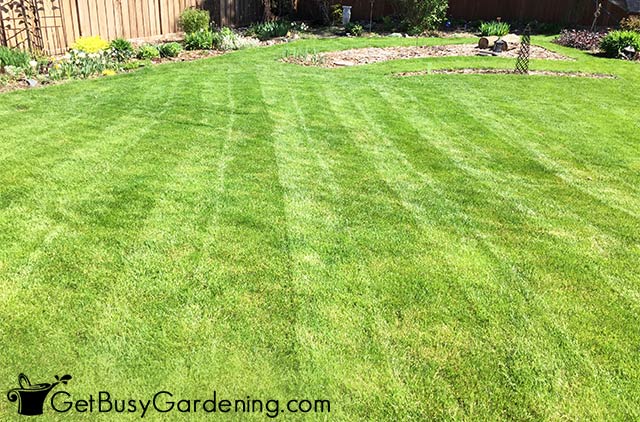
Creating stripes and designs in your lawn is easy, and it won’t take you any extra time to mow once you get the hang of it. Here are a few tips and tricks to remember when you’re just getting started…
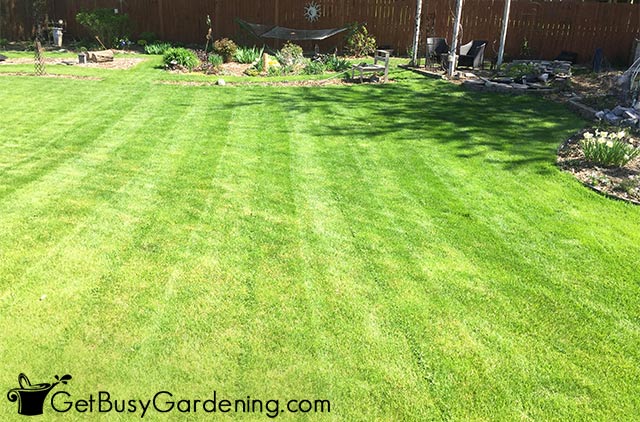

When you learn how to use lawn mowing techniques and patterns, your grass will be much healthier and easier to maintain. Plus, it will look amazing too.
Share you favorite lawn mowing patterns or tips in the comments section below.

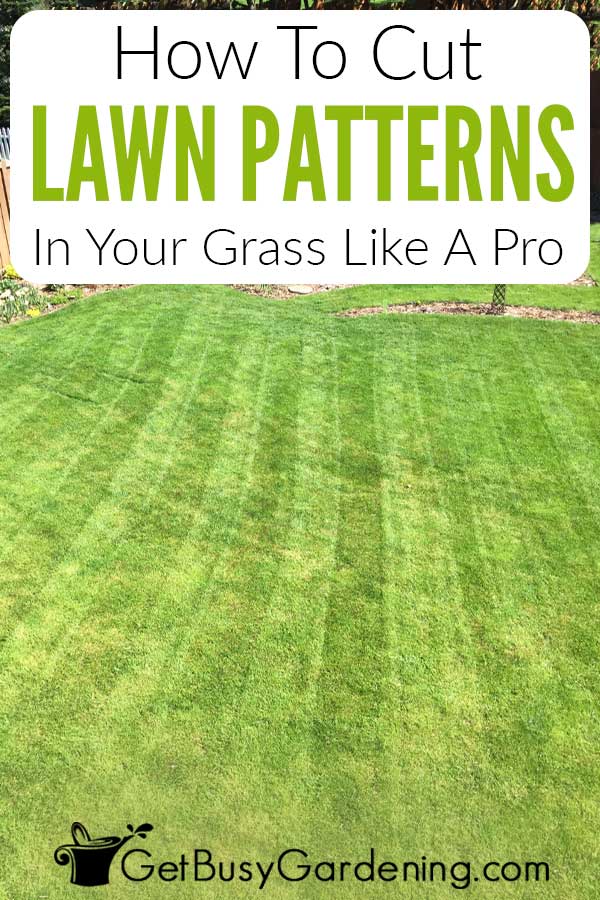
I'm the founder and owner of Get Busy Gardening, a book author, and an expert gardener. I love growing ALL of the plants. From vegetables, herbs, fruits, and flowers, to cacti, succulents, tropicals, and houseplants - you name it, I've grown it! When I'm not in the garden, you'll find me canning, pickling, cooking, and preserving all of my homegrown food. My green thumb comes from my parents, and I've been gardening for most of my life. Read More.
Thanks for the tips. How would you approach a lawn that has more curves then straight lines? I do cut the perimeter first, but like you said, wheel tracking happens.
Yes, mowing around lots of curves is difficult. I always cut the curves at different angles each time I mow (as much as I can), or at least go in opposite directions each time. Also, if you have a push mower, don’t use the power assist around the tight corners, or the wheels can spin if it gets caught on some edging and cause wear spots in the grass.
I started mowing a different pattern when I saw the tire marks before I mowed. Now I start the season mowing north and south, and rotate 45 degrees clockwise with each successive mowing. A little OCD, I know, but I think it looks better. I mow about 3/4 acre, so th pattern shows up.
Awesome! I feel OCD about using mowing patterns too, LOL! But it looks so much nicer, and it’s better for the grass too. Great work!
All great tips , didn’t know to lower deck before
winter. Also, sharp mulching blades make a nice
Clean cut . Cleaning up edges after mowing inhances the
Effort you’ve put into job , it doesn’t take a lot of time to go that extra mile to show off your pride of work !
Thanks for all the great tips !
Brendan ?
Thank you for all te wonderful tips on how to mower like a pro. I will make sure my hubby read this post so he can start mowing like pros.

Hi, I'm Amy, gardening expert, book author, and lover of ALL of the plants. I want to help you learn how to garden, indoors or out, and grow, cook, and preserve your own food with tons of tips and advice to help you along the way.
Subscribe to Our FREE Email Newsletter
Expert gardening advice straight to your inbox!
By clicking the button you are agreeing to receive our email newsletter. You can unsubscribe at any time. Read our privacy policy for the full story on how we protect and manage your submitted data.







Amy Andrychowicz is a gardening expert, book author, and the creator of Get Busy Gardening®. She is devoted to helping new gardeners learn through her life-long experience with encouragement, guidance, and advice that's easy to understand.
Read More.